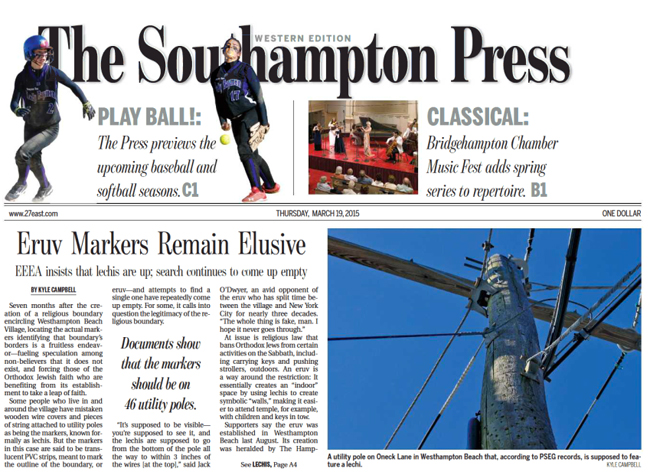The Southampton Press, in its top story yesterday, unmasked the alleged Jewish eruv boundary in Westhampton Beach as a fake, finding no evidence of the required “lechi” markers.
The SH Press and its online version 27east.com carry the headline, “Eruv Markers Remain Elusive.” It is the story at the top of yesterday’s SH press and has a photo of a utility pole.

Reporter Kyle Campbell obtained the location of the 46 poles that supposedly have lechis via a Freedom of Information request filed with the Long Island Power Authority. The same information was obtained by the O’Dwyer Co.
We looked for lechis on about a dozen of the poles last weekend and only saw one suspected lechi—a wooden strip near the bottom of the pole. It was not a lechi.
A picture of a lechi, a four-foot black strip of plastic, is shown in a photo on the 27east.com website that is copyrighted and cannot be reproduced here. However, it can be seen by accessing this link.
Campbell and no doubt other SH reporters went to every one of the 46 poles listed by LIPA as licensed to bear lechis. Assistant general counsel Justin Bell told both Campbell and this reporter that LIPA had no information as to whether any lechis were actually attached to the poles.
A map showing the location of all the poles is in the printed edition of the Southampton paper. As of press time, the story has not been posted in 27east.com.
SH Press, Newsday, etc., Fed False Info
Campbell and the SH Press deserve a Pulitzer Prize for sticking with this story which is a political hot potato while other major media such as the New York Times, Newsday, New York News and New York Post show little if any interest in a legal battle that is costing multi-millions.
Last NYT story on the battle was on Feb. 4, 2013.
The Jewish Daily Forward carried a story March 15 but it was superficial, providing no links to critical documents such as legal decisions and criticism of eruvim by ULCA Law Prof. Alexandra Susman and others.
The SH Press is no doubt angry that it was fed false information on Aug. 8, 2014 which caused it to run a long story with the headline, “Jewish Religious Boundary Goes Up In Westhampton Beach.”
Rabbi Marc Schneier of the Hampton Synagogue and Synagogue president Morris Tuchman announced in a press release that the eruv had been constructed.
An eruv converts public space into the “private domain” or "home" of the observant which frees them from many restrictions related to carrying and pushing objects. However, even in an eruv they are not allowed to use an umbrella if it's raining since that would be work--"building a tent." The Sabbath is supposed to be a day of complete rest. Lights cannot be turned on or off.
However, critics such as Susman and law Prof. Marci Hamilton of Yeshiva University say that the approval required of a local government for an eruv puts it in violation of the Constitution which calls for separation of church and state and forbids any “entanglement.”
Hamilton authored an 18-page memorandum specifically for Westhampton Beach in 2008. A copy of this has been delivered along with other materials to WHB Mayor Marie Moore.
Lawyers, Rabbis Reject Story
Faced with this hard evidence, neither representatives of the Synagogue, the East End Eruv Assn., or its law firm, Weil, Gotshal & Manges, would back down.
Robert Sugarman, lead attorney on the issue at Weil, told Campbell that the lack of visibility of the markers only furthers his argument that the eruv is not causing any type of damage to village residents who do not follow Orthodox Judaism.
Sugarman is quoted as saying, “This is an issue which is internal in the Jewish community—it doesn’t have any impact, and you speaking to a rabbi is not going to change that.”
Campbell had asked Sugarman to supply contact info for the rabbi who certified the eruv. He evidently refused to give it. Sugarman is further quoted as saying, “The whole focus that has been put on this is irrelevant. It simply doesn’t matter.”
He told Campbell the entire village of WHB falls within the eruv.
Eruv, Imaginary or Not, Is Wrong
The alleged eruv in WHB, which appears to exist only in the imagination of the Orthodox and its lawyers, is wrong even if that is its only existence.
It supposedly converts public space into the “home” of the observant and would be a magnet for others of the sect to settle in WHB, giving one religion a giant, unconstitutional favor.
Those who want to block religious symbols from being on public property 365 days a year should read the decision of Judge William Bassler of New Jersey Federal District Court who ordered the eruv in Tenafly, N.J., dismantled.
It is far more reasonable than the Appeals Court decision by Judge Thomas Ambro that overturned it.
That decision compared the permanent lechi symbols to number signs nailed to utility poles, directional signals bearing crosses, lost animal signs and orange ribbons placed by high school students.
That was an odious and inaccurate comparison. Lechis (if they are there) are symbols as powerful to the Orthodox as the sign of the cross is to Christians and the star and crescent is to Muslims.


 Husch Blackwell Strategies has added FleishmanHillard alum Michael Slatin as a principal in its public affairs group.
Husch Blackwell Strategies has added FleishmanHillard alum Michael Slatin as a principal in its public affairs group. Rory Cooper, a veteran Republican operative and policy specialist, has joined Teneo’s Washington office as senior managing director in its strategy & communications practice.
Rory Cooper, a veteran Republican operative and policy specialist, has joined Teneo’s Washington office as senior managing director in its strategy & communications practice. Brian Fallon, who served as national press secretary for Hillary Clinton’s 2016 presidential run, is signing on next month as Vice President’s Kamala Harris’ campaign communications director.
Brian Fallon, who served as national press secretary for Hillary Clinton’s 2016 presidential run, is signing on next month as Vice President’s Kamala Harris’ campaign communications director. TikTok is nothing more than a Chinese propaganda tool that poses “a grave threat to America’s national security and, in particular, impressionable children and young adults,” say two Congressmen who want the platform registered as a foreign agent.
TikTok is nothing more than a Chinese propaganda tool that poses “a grave threat to America’s national security and, in particular, impressionable children and young adults,” say two Congressmen who want the platform registered as a foreign agent. Public Strategies Washington has added Abbie Sorrendino, a former aide to now Senate Majority Leader Chuck Schumer.
Public Strategies Washington has added Abbie Sorrendino, a former aide to now Senate Majority Leader Chuck Schumer.


 Have a comment? Send it to
Have a comment? Send it to 
No comments have been submitted for this story yet.